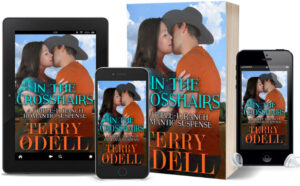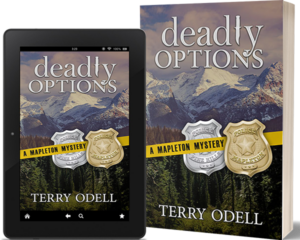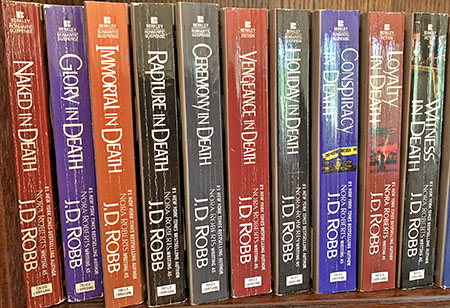A Balancing Act
Terry Odell
I’m about 14K into my next novel, the tenth offering in my Mapleton Mystery series. Unlike my other series, which fall under the romantic suspense umbrella, my Mapletons are a true series, not a set of connected books. Although my romantic suspense series feature recurring characters, the protagonists are different in each. In Mapleton, my police chief, Gordon Hepler (who got his name when a postal clerk where I did a lot of mailing begged to be included. Neither of us had any idea he’d be a series protagonist) is the POV character in almost every story.
While I face the same issues with all series, the Mapleton books are more challenging. Why? The dreaded backstory conundrum. The setting, with a few detours, is the small town of Mapleton. The books progress in time from one to the next, so I’m continually balancing content that will offer enough explanation for new readers while not boring returning ones. By book ten, a LOT of things have transpired, and while my characters have a good idea of what’s gone before, readers might not.
Stopping to info dump bores new readers and can insult those ‘in the know.’ However, the occasional Easter egg makes a welcome reward. Overexplaining things or detailed character descriptions will have returning readers skimming. The further into the series I get, the sketchier descriptions become. John Sanford once said he includes a short paragraph with the highlights of Lucas Davenport in each novel—tall, lean, dark hair, facial scar, clothes horse—and that’s about it.
What kind of information has accumulated over the series? To name a few:
Gordon had Central Serous Retinopathy in an early book, takes blood pressure meds, and has to limit his caffeine intake. While this was a major plot thread in Deadly Puzzles, there’s no need to give readers the entire history in each book. But he’s a cop and he’s drinking decaf? Will readers wonder?
Angie has grown from character of interest to girlfriend to lover to wife throughout the series. They were newlyweds in Deadly Fun but now, they’re settling into the marriage. Angie runs the local diner, had a side business of catering with another character prominent in several books. There’s her cook who appears regularly and the rest of the staff of the diner who appear from time to time.
There are the other officers on the police force, and their number has increased. There are the dispatchers and Gordon’s admin, all of whom play their own parts in the stories. And we can’t forget Buster, the department’s part-time K-9 who shows up in this new book. Is that enough, or do I need to show that when he’s not doing police work, he lives with Officer Solomon? Should I mention his wife and kids?
Mapleton has had several mayors, each a thorn in Gordon’s side, and they’ve been dispatched in one way or another. Now, there’s an interim mayor and friction on the town council. There’s a newspaper reporter who often crosses a line Gordon thinks she shouldn’t when she writes her articles for the local paper.
The list goes on. And on.
You can see that trying to fit all this in would make a book far longer—and more tedious—than it needs to be. When a recurring character shows up, it’s tempting to lay in more background and description than is necessary. (Side note: since I write in Deep POV, I’m not going to intrude with my own descriptions. Those of you writing from a more distant POV might not have as much trouble.) I have to remind myself to save bits and pieces of description as well as other background information until there seems to be a logical place to do so. If Gordon’s admin has been with him since his first day on the job, he’s not going to be thinking of what she looks like every time he sees her. Now, if it seems important that readers “see” her, then maybe she’s wearing something unlike her normal office attire, or she’s changed her hairstyle. That way, Gordon’s doing the describing, not me. Or he might ask her about her family to follow up on a thread from another book.
My approach tends to be to include first, cut later. I think about having a series bible, and then think I’d probably want to include even more since I’d have everything laid out for me.
When someone asked Michael Connelly how he handles keeping readers up to speed, he said he thought about it early on and decided to take the “The other books are out there. Let them find out for themselves” approach.
JD Robb (based on her books, not asking her) throws in plenty of references to things gone before and after over 50 books in the In Death series, a lot has happened, and the cast of characters has grown tremendously. Given the state of my memory, I often wish there were footnotes for whichever book the various cases or situations she mentions. Not explanations, not backstory, not info dumping, but I’d know which book to take another look at.
What about you? How do you handle information in an ongoing series? Your preferences as a reader?
In case anyone wants to see my interview for the Speed City Sisters in Crime, you can watch the replay.
Now Available: Cruising Undercover
 It’s supposed to be a simple assignment aboard a luxury yacht, but soon, he’s in over his head.
It’s supposed to be a simple assignment aboard a luxury yacht, but soon, he’s in over his head.
 Terry Odell is an award-winning author of Mystery and Romantic Suspense, although she prefers to think of them all as “Mysteries with Relationships.”
Terry Odell is an award-winning author of Mystery and Romantic Suspense, although she prefers to think of them all as “Mysteries with Relationships.”






